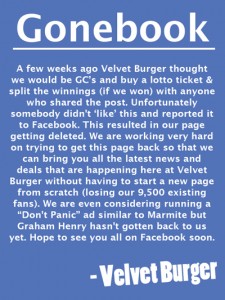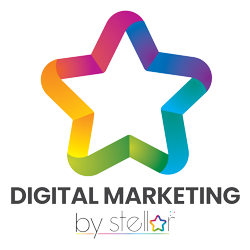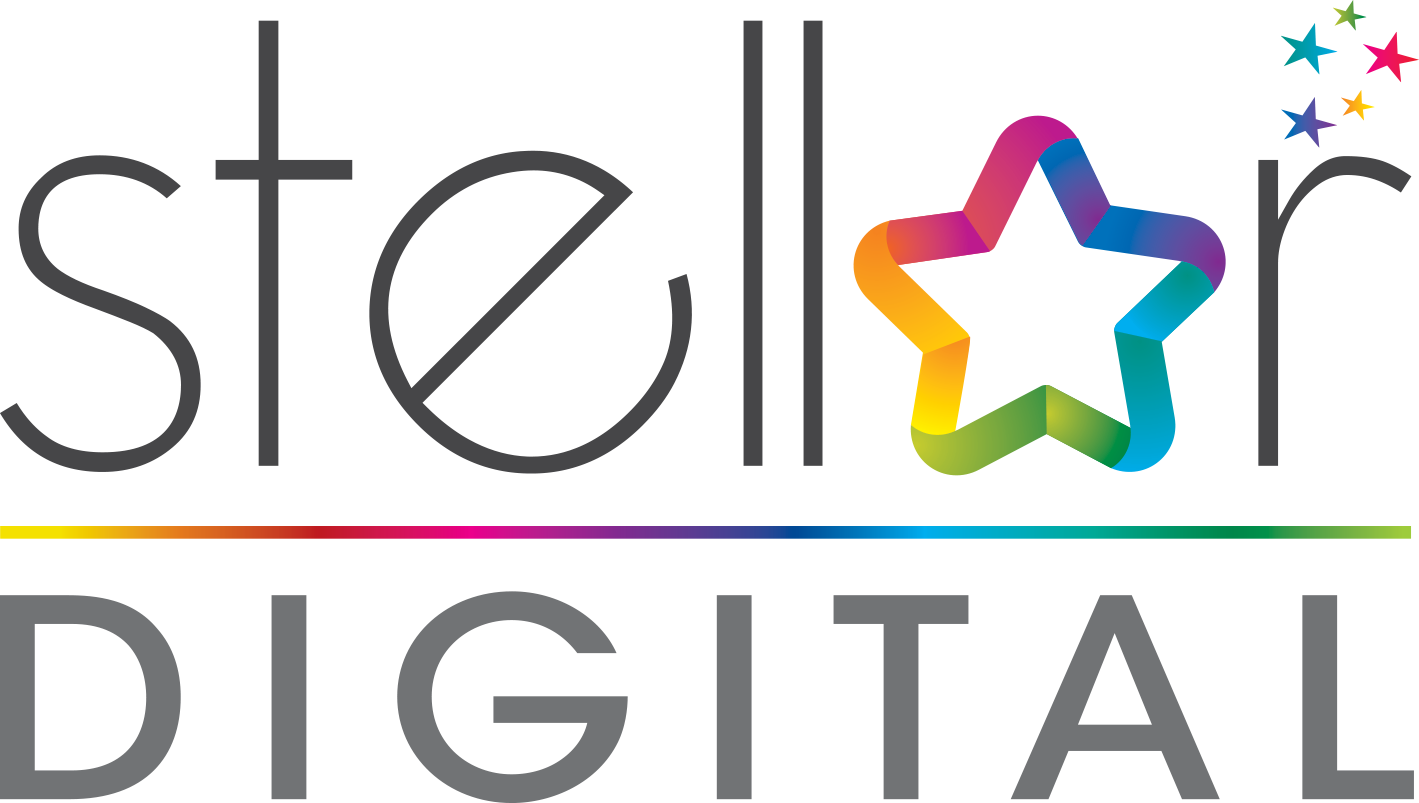Did you hear about Velvet Burger? They are one of the most recent companies to have their Facebook page deleted for breaking the rules. They waved ‘bye’ to almost 10,000 fans in the process. You can read their message to their customers below.
You may have also heard Hell Pizza went the same way – losing their page and 20,000 fans along with it. Hell managed to get their page back through someone-who-knew-someone who worked at Facebook, but sadly – in most cases – if this happens to you, you’ll be starting from scratch.
In case you’re thinking being in a little country (Velvet Burger and Hell are in New Zealand) or that having far fewer fans will prevent this from happening to you, think again! Don’t get all up in arms with Facebook about this either; the only person to blame is … you.
When you created your Facebook page for your business you ticked a box saying you’ve read and agree to the terms and conditions. I know, I know, of course you didn’t actually read them (and I don’t blame you, there are pages and pages to read) but ignorance is definitely not bliss.
As Facebook says “We reserve the right to reject or remove Pages for any reason.” And they’re not kidding. Don’t think you’ll get a warning either! Poof! One day it could just be gone.
The bad news is claiming you didn’t know you were breaking the rules won’t cause Facebook to reverse your page deletion decision.
The good news? With a little learning you can prevent the next victim being your page.
There are Facebook rules that page admins break on a daily basis, so included in the list of what you CANNOT do that follows below are no doubt many you’ve been guilty of.
Even if you’ve been playing by the rules, you might read them and think “But everyone does that! Why can’t I?” Well to paraphrase mothers around the world “If your friends jumped off a bridge, would you?” Kidding aside, it really isn’t worth flouting the rules.
So here’s my list of the most commonly broken Facebook rules you simply cannot do with your page. Pay attention so your page is not the next in line for the chopping block!
Cover photo rules
You know that lovely big new image at the top of your page? As tempting as I know it is, you cannot use it as an ad.
What does that mean? The list includes:
You cannot…
- Include your contact details – i.e.: no website address, no phone number, no email and so on. That’s what your about box and info page are for. Basically if it’s a way to get in touch with you or if there’s a field for that information on your info page, then it cannot go in your cover photo.
- Include pricing or purchase information – i.e.: ’40% off…’ or ‘Get yours now at our website…”
- Reference any “user interface element” – i.e.: you can’t ask for, mention or even use a graphic to point to Like, Share or any other Facebook feature. Facebook even makes special mention that you cannot encourage or incentivise people to upload your cover image to their personal timelines.
- Include calls to action – i.e.: ‘Get yours now’ or ‘Tell your friends’.
- Use an image you do not own or have the rights to use, that is false, deceptive or misleading.
By the way, your cover image should be 851 pixels wide by 315 pixels tall and under 100 kb in file size.
Want to read Facebook’s new cover photo rules for yourself? Here they are and here are some examples of cover photos from brands breaking the new rules.
Promotion Rules
Here’s where you’re going to feel guilty as these are broken all the time. It’s these rules that caused Velvet Burger to lose their page (and their 9,500 fans along with it).
You cannot…
- Run any sort of promotion, competition, sweepstakes etc. on your Facebook page using Facebook’s features and functionality – i.e.: make sure you use an app or ‘custom page’ and not ‘like this update’ / ‘share this photo’ / ‘upload your photo to our page’ / ‘add a comment’ (and so on) to enter (a more complete list follows below).
- Hold Facebook responsible: So you must include a disclaimer that releases Facebook of any responsibility – e.g.: You’ve got to mention something along the lines of “This promotion is in no way sponsored, endorsed or administered by, or associated with, Facebook”. This is best put on the page/s of your app and in your terms and conditions on your website.
- Following on from above, you must also disclose who the entrant is giving their information to. The usual wording is “Participants are providing information to [your company name and the name of any other companies who see entrants information] and not to Facebook.”
- Use any Facebook features or functionality as part of the promotion or participation other than liking your page, checking in or connecting to your app.
- Use Facebook features or functionality as a promotion’s registration or entry mechanism – i.e.: the act of liking your page or checking in cannot automatically register or enter the person in your promotion. Basically a condition of entry can be to like your page but the fan must then complete their entry on your Facebook app or custom page.
- Use the Like button as a way of voting (e.g.: most likes wins is not okay). Any other Facebook feature or functionality cannot be used for voting either (e.g.: The person who invites the most new fans wins …)
- Notify winners through Facebook – i.e.: don’t use Facebook message, chat or posting on the winner’s page, your page or another company’s page to notify winners.
These rules apply when promoting your promotion as well! So when you advertise (e.g.: Facebook ads) or reference a promotion (e.g.: in a Wall post) you need to follow the rules
These types of promotions are therefore NOT OK (often called Wall Promotions) because you’re using Facebook features and functionality to run the promotion:
Share this [update / photo / video etc.] to be in to win…
Upload a photo / video …
Every 25th new fan wins…
Add a comment …
Invite your friends to like our page …
Answer this question …
Photo with the most likes wins …
Data collection
Whether promotional or not, whenever you collect content or information from a Facebook user, you have to make it clear that you (and not Facebook) are collecting it.
You’ll need to notify Facebook users and obtain their consent plus tell them (or link to your website privacy policy or terms and conditions page) how their information will be used by you.
Your page name
Your page name and your Facebook username must reflect / match your company name.
So if your company sells milk called Moo Juice then your page name should be ‘Moo Juice’ or ‘Moo Juice Milk’ but not ‘Milk’ as you can’t call your page a generic term – e.g.: ‘Beer’ or ‘Pizza’.
Your page name cannot be entirely in capitals unless your organisation’s name is an acronym. So the Bank of New Zealand can call their page BNZ but just because your logo has your name all in capitals, if it’s not an acronym, your page name cannot be all caps.
You also cannot use character symbols, such as bullet points or excessive punctuation or trademark symbols, in your page name.
Facebook Ads
Before you run Facebook Ads, have a careful read through the Facebook Advertising Guidelines here. There are so many that it deserves its own article so for now you’ll have to do your own homework 😉
I think I’ve set a new record for the number of uses of the word ‘cannot’ in one article!
Given how often these rules are broken and the fact the Facebook’s terms and conditions sprawl over multiple pages; I hope you’ve learned a lot. Please consider liking or sharing this article with your network to help other business owners, marketers and page admins avoid falling into the page deletion trap! Just pick one of the sharing options at the top of the page or below, thank you.
To get more out of your Facebook pages, kindly drop me an email at Justin@StellarDigital.com.au.


0 Comments
You can be the first one to leave a comment.